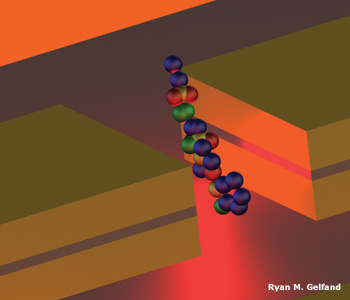Feature
Towards an Integrated Chip-Scale Plasmonic Biosensor
Biosensing allows researchers to detect tiny amounts of harmful chemicals before they become major threats. These researchers are using advanced optical technologies to develop the biosensor of the future—a plasmonic-based chip-scale device that will allow for compact, inexpensive, ubiquitous and sensitive detection.
 An illustration of a biomolecule in the gap of a metal-dielectric-metal plasmonic antenna integrated onto a quantum cascade laser.
An illustration of a biomolecule in the gap of a metal-dielectric-metal plasmonic antenna integrated onto a quantum cascade laser.
In the world of biosensing, researchers are accustomed to looking for the proverbial needle in a haystack—a very, very large haystack. Often the quantity of the chemical of interest is present in the range of parts per billion or less. Imagine, for example, a few anthrax spores hidden in a box of baking soda—certainly enough to be dangerous, but very difficult to detect. Or, in the medical realm, picture a patient with slightly raised blood levels of tumor necrosis factor, which, if detected, could indicate the beginning stages of cancer. Early detection is critical to addressing the issue, whether it be cancer, disease epidemics or an outbreak due to bioterrorism. Separating the chemical from the surrounding environment represents a great challenge.
…Log in or become a member to view the full text of this article.
This article may be available for purchase via the search at Optica Publishing Group.
Optica Members get the full text of Optics & Photonics News, plus a variety of other member benefits.
